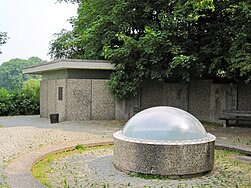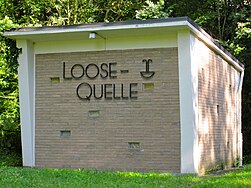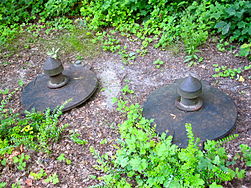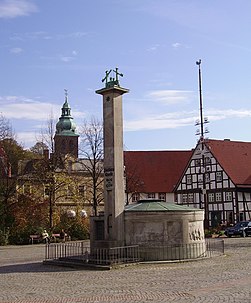Bad Salzufler thermal springs
The Bad Salzufler thermal springs were originally used for salt production and today, with nine existing springs and wells, they are an essential part of the spa and bathing operations of the city of Bad Salzuflen in the Lippe district of North Rhine-Westphalia in Germany .
definition
Water that contains at least 14 grams of dissolved substances per liter is called “ brine ” (from late Middle High German sul, sol for “salt broth”). If brine reaches the surface of the earth at more than 20 ° C, it is called " thermal brine ".
Geology and hydrogeology
The thermal springs of Bad Salzuflen are linked to a tectonic fault system in the salt valley . Regional geologically, the area belongs to the tectonically severely disturbed edge area of the Westphalian-Lippian-Keuper mountainous region . Along the deep faults mobilized penetrate deep groundwater to the surface. In the subsurface, carbonic acid , which comes from a cooled Tertiary magma , dissolves the saline rocks of the Zechstein , Röt and Middle Muschelkalk and transports the solution loads along the deep faults. At some springs the saline deep groundwater mixes with fresh water , so that the springs are characterized by different hydrogeochemical characteristics.
Readings
The most important anions ( electrically negatively charged ions ) and cations (electrically positively charged ions) were recorded in the analyzes from 1955 to 2018 :
- Anions
Bromide ion (Br - ), chloride ion (Cl - ), fluoride ion (F - ), hydrogen carbonate ion (HCO 3 - ), iodide ion (I - ), nitrate ion (NO 3 - ), Nitrite ion (NO 2 - ) and the sulfate ion (SO 4 2- )
- Cations
Ammonium ion (NH 4 + ), calcium ion (Ca 2+ ), iron ion (Fe 2+ ), potassium ion (K + ), lithium ion (Li + ), magnesium ion (Mg 2+ ), Manganese ion (Mn 2+ ), sodium ion (Na + ) and strontium ion (Sr 2+ )
history
In the last years of the 19th century the following quantities of salt were produced by the Princely Saline zu Salzuflen:
| year | 1893 | 1895 | 1896 | 1897 | 1898 |
| salt | 742,600 kg | 1,030,600 kg | 957,725 kg | 1,128,075 kg | 948,975 kg |
| Bath salts | 37,750 kg | 50,400 kg | 41,575 kg | 41,890 kg | |
| Cattle salt | 50,200 kg | 55,200 kg | 49,300 kg | 64,700 kg | 63,200 kg |
| Fertilizer salt | 136,100 kg | 136,200 kg | 181,250 kg | 170,000 kg | 182,500 kg |
| concentrated mother liquor | 2,500 l | 4,000 l | 2,500 l | 3,000 l | 1,300 l |
Springs and fountains
Gustav-Horstmann-Sprudel
Formerly: Neuthermalsprudel
Drilled: 1919 to 1927; 1969
Depth: 1,018 meters
Geology: Lower Buntsandstein
Filling: 90,000 liters per hour
Temperature: 31.9 / 37.5 / 38.0 ° C (2010/2003 / ~ 1968)
pH value: 6.6 (2010)
total dissolved Substances: 126,369 / 123,558 milligrams per liter (2010/2003)
Dissolved free carbon dioxide (CO 2 ): 2,867 milligrams per liter (2010)
Use: Baths
Hydrogeochemical characteristics: Iron and fluoride-containing thermal sol acid
coordinates:![]()
The photo below shows the Neuthermalsprudel in 1927; in the background you can see houses on Wüstener Strasse and Alte Vlothoer Strasse .
The deepest, most expensive, salty and warmest spring is the Gustav-Horstmann-Sprudel located at the end of the landscape garden, named after the Salzufler spa director Gustav Horstmann. In 1919 the difficult drilling work began through quartzitic banks of high mineral hardness, until a carbonated brine source was found at a depth of 375 meters. During a renovation in 1967, the borehole was cleared with the hardest drill bits in the world, specially flown in from the USA . The Gustav-Horstmann-Sprudel delivers 90,000 liters per hour with a mineral content of 10.9 percent at an outlet temperature of 37.5 degrees Celsius and a carbon dioxide content of 2,867 milligrams per kilogram. The spring comes from a depth of 1,018 meters and now feeds the brine pools of the VitaSol -Therme. A special feature is the clear view of the source pot through a plexiglass dome . The abundant thermal spring is tied to the intersection of two tectonic faults - the salt valley zone and the Asental fault.
- Mineral content of the Gustav-Horstmann-Sprudel
All data in milligrams per liter according to control analysis in 2018, 2010 and 2003
| Anions | bromide | chloride | fluoride | Bicarbonate | iodide | nitrate | nitrite | sulfate |
| 2018 2010 2003 |
20.1 k. A. k. A. |
69,300 69,700 70,500 |
1.11 1.10 2.44 |
1,866 2,341 2,313 |
0.062 0.070 0.070 |
5.80 3.50 7.76 |
<0.005 <0.005 <0.005 |
5,260 5,618 5,786 |
| Cations | ammonium | Calcium | iron | potassium | lithium | magnesium | manganese | sodium | strontium |
| 2018 2010 2003 |
11.4 9.8 11.1 |
1,780 1,782 1,873 |
22.6 26.7 35.3 |
455 446 465 |
k. A. k. A. 6.8 |
855 868 869 |
0.21 0.25 0.31 |
44,100 42,720 44,465 |
35.6 42.0 34.5 |
Island fountain
Drilled: 1936
Depth: 52.4 meters
Geology: reed sandstone
Filling: 300 liters per hour
Temperature: 12.4 / 12.6 ° C (2010/2003)
pH value: 6.6 (2010)
Total dissolved substances: 9,019 / 6,370 milligrams per liter (2010/2003)
Dissolved free carbon dioxide (CO 2 ): 353 milligrams per liter (~ 1968)
Use: Drinking cure
Hydrogeochemical characteristics: Sodium-calcium-chloride-sulfate-water
Coordinates:![]()
The island fountain was added in 1936 to supplement the Sophienquellen. He was on the island in large Kurparksee in 52.4 meters deep drilled and comes backed by a pump station directly into the well serving the foyer. He develops a mineral water that comes from the sandstone reed .
- Mineral content of the island well
All data in milligrams per liter according to control analysis in 2003 and 2010
| Anions | chloride | fluoride | Bicarbonate | iodide | nitrate | nitrite | sulfate |
| 2010 2003 |
4,017 2,550 |
<0.20 0.25 |
477 396 |
0.010 <0.005 |
<0.5 <0.5 |
<0.005 <0.005 |
1,319 1,224 |
| Cations | ammonium | Calcium | iron | potassium | lithium | magnesium | manganese | sodium | strontium |
| 2010 2003 |
0.29 0.27 |
626 535 |
3.60 3.66 |
11.40 9.33 |
k. A. 0.21 |
114 95 |
0.18 0.13 |
2,436 1,547 |
14.70 9.14 |
Leopoldsprudel
Drilled: 1904/1906
Depth: 534 meters Filling:
1,500 to 2,000 liters per minute
Temperature: 21.7 ° C
Total dissolved substances: 79,123 milligrams per liter
Dissolved free carbon dioxide (CO 2 ): 1,298 milligrams per liter (~ 1968)
Use: Baths
Hydrogeochemical characteristics: Thermal-Sol-Säuerling
Coordinates:![]()
In the middle of the spa park is Bad Salzuflen's landmark, the fountain temple above the Leopold thermal spring. With the development of this thermal bath in 1906, Salzuflen became a thermal bath. Godfather was the last ruling Prince of Lippe, Leopold IV. Zur Lippe (1871–1949). 1,500 to 2,000 liters per minute gush from a depth of 534 meters. This carbonated thermal spring has an outlet temperature of 21.7 degrees Celsius, 7.1 percent mineral content and 1,298 milligrams per kilogram of carbon dioxide content. The fountain temple, built in 1910, is a listed building. Immediately after the drilling, the thermal water from the Lower Muschelkalk flowed artesian at 70 cubic meters / hour .
- Mineral content of the Leopoldsprudel
All data in milligrams per liter according to an analysis in 1955
| Anions | bromine | chloride | fluoride | Bicarbonate | iodide | nitrate | nitrite | sulfate |
| 1955 | 32.55 | 39,458 | k. A. | 1,616.5 | 1.35 | 0.5 | 0 | 2,959.6 |
| Cations | aluminum | ammonium | Calcium | iron | potassium | lithium | magnesium | manganese | sodium | strontium |
| 1955 | 3.88 | 2.44 | 3,020 | 38.44 | 313 | 1.75 | 532.6 | 0.11 | 23,175 | 45.5 |
Loose source
Drilled: 1889/1891
- Newly drilled: 1964/1965
Depth: 400 meters
- New depth: 64 meters
Geology: Upper Buntsandstein
Filling: 25,000 liters per hour (1891)
- New filling: 75,000 (1965), today throttled
Temperature: 14, 25 / 14.2 / 13 ° C (2010/2003/1899)
pH value : 6.6 (2010)
Total dissolved substances: 6,114 / 5,916 milligrams per liter (2010/2003)
Dissolved free carbon dioxide (CO 2 ): 616 Milligrams per liter (~ 1968)
Use: Drinking cure
Hydrogeochemical characteristics: Sodium-calcium-chloride-sulphate-hydrogen carbonate-water
Coordinates:![]()
The picture below shows the old well house of the Loose Spring in the early 1920s.
Even before 1600 there was a weakly mineralized spring on the Loose, the Loosebrunnen. However, its importance for the bathing industry only began in 1889/1891 when a borehole was set up to 400 meters deeper to develop the layers: 25,000 liters gushed out per hour, the main inflow of the spring is 134 meters deep, in layers of shell limestone . The sulphate content in mineral water, on the other hand, comes from the rocks of the gypsum keuper .
In the mid-1960s, the spring was re-drilled to a depth of 64 meters, the output of 75,000 liters per hour is throttled by means of a gate valve so that only a small amount overflows. Twice a week, the water from the loose spring is transported to the foyer in the Salzufler Kurpark for drinking cures.
- Mineral content of the loose spring
All data in milligrams per liter according to control analysis in 2018, 2010 and 2003
| Anions | bromide | chloride | fluoride | Bicarbonate | iodide | nitrate | nitrite | sulfate |
| 2018 2010 2003 |
0.53 k. A. k. A. |
1,750 1,796 1,736 |
0.36 0.44 0.47 |
826 929 927 |
<0.005 <0.005 <0.005 |
<0.50 <0.50 0.72 |
<0.005 <0.005 <0.005 |
1,240 1,385 1,298 |
| Cations | ammonium | Calcium | iron | potassium | lithium | magnesium | manganese | sodium | strontium |
| 2018 2010 2003 |
0.22 0.25 0.24 |
495 547 564 |
3.54 5.30 5.43 |
12.3 12.3 12.1 |
k. A. k. A. 0.23 |
90.0 92.5 94.3 |
0.10 0.13 0.14 |
1,290 1,327 1,259 |
12.6 19.5 17.6 |
Unit of information not described; Analysis before April 1899
| Chlorine- sodium |
Chlorine- potassium |
Chlorine lithium |
Chlorine- calcium |
Sodium bromide |
lime | magnesia | Iron and manganese oxide |
other substances |
| 6.011 | 0.072 | traces | 0.205 | traces | 1.74 | 0.361 | 0.024 | 0.017 |
New fountain
Drilled: 1913
Depth: 54 meters
Geology: Upper Gipskeuper
Filling: 10,000 liters per hour
Temperature: 12.7 / 12.2 ° C (2010/2003)
pH value: 6.4 (2010)
Total dissolved substances: 32,040 / 29,309 Milligrams per liter (2010/2003)
Dissolved free carbon dioxide (CO 2 ): 748/704 milligrams per liter (2010 / ~ 1968)
Use: Graduation, inhalation
Hydrogeochemical characteristics: Calcium sulfate sol-acid
One exception among the nine Bad Salzufler mineral springs is the Neu-Brunnen, which was developed in 1913 at a depth of 54 meters; because it is located west of the Salzetal at the corner of Goethestrasse and Obernbergstrasse, and not like the other eight springs all in the Salzetal. Its one percent brine was even shipped in bottles until the mineral content rose to 2.8 percent, so that at the end of the Second World War the shipping of the wells and in 1955 the local bar was stopped. The mineral water comes from a cleft zone in the stone marlkeuper .
- Mineral content of the new well
All data in milligrams per liter according to control analysis in 2010 and 2003
| Anions | chloride | fluoride | Bicarbonate | iodide | nitrate | nitrite | sulfate |
| 2010 2003 |
17,990 16,463 |
<0.20 0.06 |
850 781 |
0.030 <0.005 |
1.90 1.82 |
<0.005 <0.005 |
1,430 1,293 |
| Cations | ammonium | Calcium | iron | potassium | lithium | magnesium | manganese | sodium | strontium |
| 2010 2003 |
1.80 1.64 |
1,596 1,496 |
16.4 18.3 |
50.0 51.3 |
k. A. 1.06 |
503 446 |
1.20 1.16 |
9,570 8,728 |
29.0 26.7 |
Paulinenquelle
Drilled: 1802
Depth: 63 meters
Geology: Rätkeuper
Schüttung: 10,000 liters per hour
Temperature: 13.5 / 12.2 / 12.5 ° C ( 2011/2003 / ~ 1899)
pH value: 5.9 (2011)
total Dissolved substances: 78,948 / 81,334 milligrams per liter (2011/2003)
Dissolved free carbon dioxide (CO 2 ): 1,540 milligrams per liter (2011)
Use: Inhalation , grading
Hydrogeochemical characteristics: Sol-acid
coordinates:![]()
The picture below shows the old pump tower above the Paulinenquelle around 1920. It was demolished around 1934 for the erection of today's fountain monument.
Bad Salzuflen's oldest well-preserved spring is the Paulinenquelle on the Salzhof, drilled at a depth of 63 meters in 1802 and named after Princess Pauline zur Lippe (1769–1820). The Salzuflen spa did not exist at that time, but the drilling to secure the brine for salt production was very important. With a mineral content of 7.6 percent and 1,540 milligrams of free carbon dioxide per kilogram, the Paulinenquelle is a carbonic acid brine and is used today as a graduation spring. The Paulinenquelle was built over in 1934 with the fountain monument jointly designed by the architect Rudolf Günther and the sculptor Gustav Reitner and is a listed building. The source draws its water supply of incidents Rhät - sandstone .
- Mineral content of the Paulinenquelle
All data in milligrams per liter according to control analysis in 2011 and 2003
| Anions | chloride | fluoride | Bicarbonate | iodide | nitrate | nitrite | sulfate |
| 2011 2003 |
42,790 44,275 |
<0.20 0.31 |
1,800 1,788 |
0.059 0.047 |
1.7 <0.5 |
<0.005 <0.005 |
4,060 1,224 |
| Cations | ammonium | Calcium | iron | potassium | lithium | magnesium | manganese | sodium | strontium |
| 2011 2003 |
7.20 6.94 |
1,972 1,958 |
19.1 21.3 |
180 181 |
2.5 3.9 |
569 574 |
0.46 0.48 |
27,490 27,564 |
43.1 32.6 |
Unit of information not described; Analysis before April 1899
| Chlorine- sodium |
Chlorine magnesium |
Sodium bromide |
Baking soda | lime | magnesia | Iron and manganese oxide |
other substances |
| 33.978 | 1.934 | traces | 0.52 | 2.853 | 0.076 | 0.014 | 0.033 |
Sophienbrunnen
Drilled: 1953
Depth: 12.5 meters
Geology: Upper Gipskeuper
Filling: 300 liters per hour
Temperature: 14.5 / 11.7 ° C (2010/2003)
pH value: 6.3 (2010) Total dissolved substances: 27,468 / 28,418 milligrams per liter (2010/2003)
Dissolved free carbon dioxide (CO 2 ): 939/179 milligrams per liter (2010 / ~ 1968)
Use: drinking cure
Hydrogeochemical characteristics: Sodium-calcium-chloride-water
The Sophienbrunnen, like the Sophienquelle, named after Princess Sophie zur Lippe (1834–1904), was opened in 1925 near the old drinking hall in the spa gardens at a depth of 18 meters. In the course of time, fresh water flowed in again and again, so that in 1953 today's Sophienbrunnen was reopened near the Leopoldsprudel. Its mineral content is 1.1 percent. Hydrogeochemically, it is a mixture of fresh water, which comes from the Quaternary Talkies, and mineral water of the stone marl keuper . It is led through a pipe directly into the fountain bar in the foyer. It is the most mineral-rich of the three Salzufler drinking fountains.
- Mineral content of the Sophienbrunnen
All data in milligrams per liter according to control analysis in 2010 and 2003
| Anions | chloride | fluoride | Bicarbonate | iodide | nitrate | nitrite | sulfate |
| 2010 2003 |
14,000 14,700 |
<0.20 0.18 |
1,058 1,068 |
0.02 0.02 |
0.98 4.06 |
<0.005 0.037 |
2,090 2,071 |
| Cations | ammonium | Calcium | iron | potassium | lithium | magnesium | manganese | sodium | strontium |
| 2010 2003 |
2.20 2.19 |
1,073 975 |
13.1 18.9 |
70.0 57.2 |
1.10 1.49 |
241 236 |
0.31 0.35 |
8894 9625 |
20.2 18.8 |
Sophia sources a and b
Drilled: 1839/1962
Geology: Gipskeuper
fill: 11,000 liters per hour
- a
Depth: 49.6 meters
Temperature: 15.3 / 13.05 ° C (2010/2003)
pH value: 6.3 (2010)
Dissolved free carbon dioxide (CO 2 ): 871 / 1,640 milligrams per liter (2010 / ~ 1968)
Use: Graduation
Hydrogeochemical characteristics: Calcium-Sulphate-Sol-Säuerling
- b
Depth: 9.0 meters
Temperature: 13.55 ° C (2003)
Dissolved free carbon dioxide (CO 2 ): 484 milligrams per liter (~ 1968)
Use: Baths
Hydrogeochemical characteristics: Brine
The Sophienquellen (a) and (b), named after Princess Sophie zur Lippe (1834–1904) between 1875 and 1882, are quasi twin daughters to support the Paulinenquelle on the "Bleiche". It opens up the saline deep waters of the Gipskeuper at a drilling depth of 216 m . Two different mineral waters came to light there, one of which was used for bathing and the other for salt extraction. In 1960 the springs were closed and replaced by two new boreholes 50 meters away. One silted up and was closed again in 1984. The second is 49.6 meters deep and still provides five and a half percent carbonic acid brine.
- Mineral content of the Sophienquelle ( a )
All data in milligrams per liter according to control analysis in 2010 and 2003
| Anions | chloride | fluoride | Bicarbonate | iodide | nitrate | nitrite | sulfate |
| 2010 2003 |
14,210 33,625 |
<0.20 0.14 |
1,043 1,477 |
0.020 0.037 |
2.90 3.96 |
<0.005 <0.005 |
2,131 2,321 |
| Cations | ammonium | Calcium | iron | potassium | lithium | magnesium | manganese | sodium | strontium |
| 2010 2003 |
2.70 5.62 |
1,041 2,076 |
10.9 36.5 |
667 144 |
k. A. 3.12 |
258 536 |
0.32 0.77 |
8,537 19,764 |
16.9 34.2 |
Source a or b and unit of information not described; Analysis before April 1899
| Chlorine- sodium |
Chlorine magnesium |
Sodium bromide |
Potash | Baking soda | lime | magnesia | Iron and manganese oxide |
other substances |
| 39.778 | 1,974 | traces | 0.651 | 3.834 | 3,495 | 0.018 | 0.026 | 0.059 |
Thermal spring III
Drilled: 1956 to 1960
Depth: 412.75 meters
Geology: Lower Keuper
bed: ~ 75,000 liters per hour
Temperature: 20.9 / 21.4 ° C (2010/2003)
pH value: 6.2 (2010)
total dissolved Substances: 73.901 / 61.647 milligrams per liter (2010/2003)
Dissolved free carbon dioxide (CO 2 ): 1.550 / 2.261 milligrams per liter (2010 / ~ 1968)
Use: Baths
Hydrogeochemical characteristics: Iron and fluoride-containing thermal sol acid
coordinates:![]()
Therme III is located directly in the entrance area of the spa guest center. The youngest spring, drilled from 1956 to 1958, delivers about 25 liters of brine per second in a throttled manner and is a special attraction in the spa guest center with its bubbling fountain structure. The spring has an outlet temperature of 21.4 degrees Celsius, a mineral content of 6.5 percent and a carbon dioxide content of 2,261 milligrams per kilogram. The main tributaries of the source are in the rocks of the Lower Keuper and Upper Muschelkalks .
- Mineral content of the thermal spring III
All data in milligrams per liter according to control analysis in 2010 and 2003
| Anions | chloride | fluoride | Bicarbonate | iodide | nitrate | nitrite | sulfate |
| 2010 2003 |
40,980 33,500 |
0.84 1.51 |
1,712 1,617 |
0.060 0.036 |
2.90 3.23 |
<0.005 <0.005 |
3,721 3,387 |
| Cations | ammonium | Calcium | iron | potassium | lithium | magnesium | manganese | sodium | strontium |
| 2010 2003 |
7.20 6.09 |
1,782 1,532 |
33.1 28.9 |
187 166 |
k. A. 3.52 |
573 457 |
0.12 0.14 |
24,860 20,917 |
42.2 27.4 |
literature
- Spa director August W. Diekmann: Bad Salzuflen - 150 years of tradition and progress in: "Heimatland Lippe" - magazine of the Lippischen Heimatbund and the Landesverband Lippe, No. 4/1969, Detmold, p. 126ff.
- Dipl.-Ing. Hans-Joachim Bindszus: The mineral springs of Bad Salzuflen in the past and present in: "Heimatland Lippe" - magazine of the Lippischen Heimatbund and the Landesverband Lippe, No. 4/1969, Detmold, p. 135ff.
- Dr. Rainer Lübking (Ed.): Sole in Bad Salzuflen - Interesting and worth knowing about the treasure from the depths . Bergmann.Druck, Bad Salzuflen-Schötmar 2014, ISBN 978-3-00-043444-0 .
- Franz Meyer (Ed.): Bad Salzuflen - Epochs of City History . Publishing house for regional history, Bielefeld 2007, ISBN 978-3-89534-606-4 .
- Heinz Simonsen: Investigations of the acidity and secretion conditions of the stomach after a single administration and after a drinking cure with the Salzufler Inselbrunnen . o. O., 1944, DNB 57156254X (Dissertation University of Münster, Medical Faculty, 1945, 29 pages).
Web links
- Staatsbad Salzuflen: brine - power from the Salzufler healing springs
- Private page Source Atlas: Bad Salzuflen (PDF)
Individual evidence
- ^ Hans Murawski , Wilhelm Meyer : Geological dictionary . 12., revised. and exp. Edition. Spektrum, Akademischer Verlag, Heidelberg 2010, ISBN 978-3-8274-1810-4 , p. 154 .
- ^ German Spa Association e. V .: Definitions: Quality standards for the rating of health resorts, recreational areas and wells . 12th edition, Bonn, 2005
- ↑ Gerd Michel: Appreciation of the healing springs of Bad Salzuflen from a geological point of view . In: Heilquelle and Kurort . tape 40 . Flöttmann, Gütersloh, p. 264-269 .
- ↑ Dr. med. Ulrich Volkhausen : Annual reports 1894 to 1899 of the Physikus for the Physikat Salzuflen in: Wolfgang Bender: "The hand on the pulse of time - Lippian everyday history of the late 19th century in the mirror of official medical reports", Lippische Geschistorquellen , ISBN 3-923384-15-7 , Detmold, 2000, pp. 21 to 156.
- ↑ Heimatland Lippe, No. 4, July 1969, p. 140
- ↑ a b c d e f g h i Werner Käß, Hanna Käß: German bath book . Ed .: Association for Pools and Climate Knowledge eV 2nd edition. E. Schweizerbart'sche Verlagbuchhandlung (Nägele and Obermiller), Stuttgart 2008, ISBN 978-3-510-65241-9 , p. 855-862 .
- ↑ Medicinal water. Control analysis of thermal brine 2018 at www.vitasol.de, accessed on April 24, 2020.
- ^ Andreas Thurner: Hydrogeology , page 17; 1955
- ↑ Source analysis 2018 of the Losebrunnen at www.staatsbad-salzuflen.de, accessed on April 24, 2020.
- ↑ Princely bathing administration Salzuflen, April 1899
- ↑ Glossary. (No longer available online.) Staatsbad Bad Salzuflen, archived from the original on June 1, 2015 ; accessed on May 31, 2015 .













